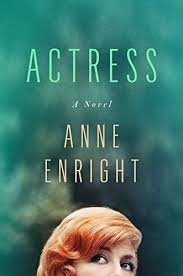REVIEW: Anne Enright's Fictional Memoir of a Beguiling Anglo-Irish Actress
/Actress by Anne Enright (W.W. Norton, 391 pages)
By Robert Allen Papinchak
Man Booker prize-winner (The Gathering) Anne Enright’s beguiling fictional biographical memoir, Actress, reads like an extended prose version of a Robert Browning dramatic monologue.
Addressed by a first person speaker to an unidentified “you,” the Browning version, usually delivered with an edge of clueless irony about a subject and a situation, slowly reveals as much about the speaker as it does about the person spoken about.
In this case, Enright takes some time to reveal who the “you” is at the same time that the reader gains knowledge about the subject and the first person narrator gains self-awareness as the story develops.
The actress who is the subject of this very Anglo-Irish novel is Katherine O’Dell. The legendary star of stage and screen—from Dublin to London to Hollywood—steps into the spotlight at age ten (playing a crocus), is finished at forty five, and dead at fifty eight.
In between those years, she established herself as an artist who was about “sincerity, courage, [and] self-sacrifice.” She “had the ability to be over the top, just by standing still.” She was also a “great Irish disaster . . . a great piece of anguish, madness and sorrow.” She was also a great fake.
This according to the narrator of Actress, Katherine’s successful novelist daughter, Norah FitzMaurice. It is she, at the provocation of young doctoral candidate, Holly Devane, seeking to “de-iconise” Katherine, who is the novel’s incisive narrator. As much as she wants to learn more about her mother, she also wants to learn more about herself. Especially about her unknown father.
Reluctant to reveal too much about her mother’s secrets before she has uncovered them herself, Norah invites Holly to her house in Bray, Ireland, to scope out Holly’s motives. When she thinks the officious grad student is “more crucially about her refusal of the hetero-normative” way and more about exposing her mother’s “sexual style,” Norah takes it upon herself to research her mother’s true story. The remainder of the novel unveils facts about her mother and herself, turning into the expansive revelatory monologue.
Despite the fact that the press recognized Katherine as “the most Irish actress in the world,” Norah knows that her mother, in fact, was British, born in Herne Hill, a suburb of London. Her parents, Menton FitzMaurice and Katherine Anne Odell, were strolling players.
Later, for the stage, Katherine takes her mother’s surname; the apostrophe is added in America and she becomes “Irished.” On stage in Dublin and London she was the embodiment of the red-headed, fair-skinned, hazel-eyed stereotypical colleen. Her voice was “gorgeous, a fake Irish accent which turned into a symbolic Irish accent, [l]ike something you could eat.” On Broadway at twenty, a six-week run in a kitchen sink melodrama turns into twenty-three weeks; she becomes the talk of the town. Soon cast in her “defining role” in a tearjerker, Hollywood calls, giving her “lasting fame” in the film version of the play.
The studio remakes her, marries her off to her gay best friend (one of her co-stars from the theater), owns her new “image, if such a thing could be legally owned,” then quickly destroys her. By thirty, fame has fled, she’s washed up, replaced by a nineteen-year old born in New Jersey who had “the kind of face producers finally required . . . with pale lipstick and the indifferent look of a woman who might have sex in various different positions, just because she is bored. She was modern.”
Katherine’s ignominious decline was marked by a commercial that followed her relentlessly. Like “Where’s the beef?,” the tag line was a “stupid catchphrase [that] refused to go away.” Delivered in a “melancholy way,” the refrain, “’Sure, ‘tis only butter’” became part of the “national conversation,” seeming to “sum up something about futility and pleasure.”
In later years, her diminished career included embarrassingly awkward nude appearances on the French stage in post-modern catastrophes for a Polish director.
Her fame eventually turned to infamy when she shot an Irish film producer in the foot, “spawning a hundred Dublin punchlines,” leading to a trial which sent her to an asylum having been declared certifiably mad.
While Actress separates the facts from the myths about her mother, Norah tries to discover the motive for the attack on the producer. She also tries to uncover the identity of her unnamed father.
In the process, the reader learns that the “you” the story is addressed to is Norah’s husband of almost forty years. He remains in the background though it is he who urges her to “write the damn book” that might in fact be Actress.
In the course of the novel much is revealed about Norah’s assiduous sex life, from early encounters through college relationships, including with one of her lecturers who was more than twice her age because she was “chasing Daddy.”
Actress is entertaining and engrossing. It seems so real that a reader might expect to see photographs. The story is grounded in reality but fabricated on the “cardboard, greasepaint, and panic” of the theater world. The gravitas of the title is deeply rooted in the complicated, never-ending generational ties between mother and daughter. This is the stellar must-read novel of the year.
Robert Allen Papinchak is a former university English professor whose reviews, essays, and criticism have appeared in numerous newspapers, magazines, literary journals, and online. This includes Publishers Weekly, On the Seawall, The Millions, World Literature Today, the Los Angeles Review of Books, the Washington Independent Review of Books, and elsewhere. His fiction has been nominated for the Pushcart Prize and won a STORY award. He is the author of Sherwood Anderson: A Study of the Short Fiction.










